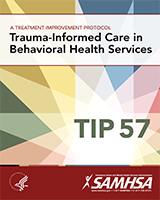Trauma-Informed Care in Behavioral Health Services
Treatment Improvement Protocol (TIP) Series, No. 57
Authors
Center for Substance Abuse Treatment (US).Excerpt
Many individuals experience trauma during their lifetimes. Although many people exposed to trauma demonstrate few or no lingering symptoms, those individuals who have experienced repeated, chronic, or multiple traumas are more likely to exhibit pronounced symptoms and consequences, including substance abuse, mental illness, and health problems. Subsequently, trauma can significantly affect how an individual engages in major life areas as well as treatment.
This TIP provides evidence-based and best practice information for behavioral health service providers and administrators who want to work more effectively with people who have been exposed to acute and chronic traumas and/or are at risk of developing traumatic stress reactions. Using key trauma-informed principles, this TIP addresses trauma-related prevention, intervention, and treatment issues and strategies in behavioral health services. The content is adaptable across behavioral health settings that service individuals, families, and communities—placing emphasis on the importance of coordinating as well as integrating services.
This publication was produced under contract numbers 270-99-7072, 270-04-7049, and 270-09-0307 by the Knowledge Application Program (KAP), a Joint Venture of The CDM Group, Inc., and JBS International, Inc., for the Substance Abuse and Mental Health Services Administration (SAMHSA), U.S. Department of Health and Human Services (HHS). Andrea Kopstein, Ph.D., M.P.H., Karl D. White, Ed.D., and Christina Currier served as the Contracting Officer’s Representatives.
Suggested citation:
Substance Abuse and Mental Health Services Administration. Trauma-Informed Care in Behavioral Health Services. Treatment Improvement Protocol (TIP) Series 57. HHS Publication No. (SMA) 13-4801. Rockville, MD: Substance Abuse and Mental Health Services Administration, 2014.
The views, opinions, and content expressed herein are the views of the consensus panel members and do not necessarily reflect the official position of SAMHSA or HHS. No official support of or endorsement by SAMHSA or HHS for these opinions or for the instruments or resources described are intended or should be inferred. The guidelines presented should not be considered substitutes for individualized client care and treatment decisions.
